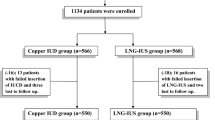Abstract
A randomized comparative study was made in New Zealand of 3 models of copper IUDs, the Nova-T, MLCu375 and MLAgCu250, with interval acceptors. Completing 3 years of use, there were 608 Nova-T (14 011 woman-months), 586 MLCu375 (14 161 woman-months) and 596 MLAgCu250 (14 614 woman-months). At 3 years, loss to follow-up was 5.2% for the Nova-T, 5.1% for the MLCu375 and 4.1% for the MLAgCu250. The Multiloads were significantly easier to insert and were preferred by the operators, as the insertion technique for the Nova-T was complicated. However, the Nova-T was significantly easier to remove. There was one perforation with a Nova-T in a puerperal breastfeeding woman. In the only 2 parameters that are comparable between series, accidental pregnancy and expulsion [1], the Multiloads have been shown to be superior with higher relevant continuation rates. At 3 years, the MLCu375 had a significantly lower accidental pregnancy rate and higher relevant continuation rate. The results obtained with the Nova-T are similar to those of the WHO study [2]. The MLCu375, with its potential for use up to 5 years, has been shown to be the superior device.
Resumé
Une étude comparative randomisée a été réalisée en Nouvelle-Zélande sur 3 modèles de DIU au cuivre, les Nova-T, MLCu375 et MLAgCu250, chez des femmes les utilisant à intervalles. Au terme de 3 années, ces dispositifs avaient été utilisés à raison de 608 pour le Nova-T (14.011 mois-femme), 586 pour le MLCu375 (14.161 mois-femme) et 596 pour le MLAgCu250 (14.614 mois-femme). Toujours au terme de 3 années, peu de femmes avaient abandonné le suivi, soit à peine 5,2% pour le Nova-T, 5,1% pour le MLCu375 et 4,1% pour le MLAgCu250, taux qui ne différait pas de façon significative entre les différents dispositifs. Les Multiloads étaient notablement plus faciles à insérer et préférés par les opérateurs, la technique d'insertion du Nova-T étant compliquée. Par contre, ce dernier était significativement plus facile à retirer. Il y a eu un cas de perforation par le Nova-T chez une femme qui allaitait pendant la période puerpérale. Pour les 2 seuls paramètres qui puissent être comparés entre les séries, à savoir la grossesse accidentelle et l'expulsion, les Multiloads se sont révélés supérieurs avec des taux correspondants de continuation plus élevés. Au bout de 3 ans, le pourcentage de grossesses accidentelles pour le MLCu375 était significativement plus faible et celui de continuation plus élevé. Les résultats obtenus avec le Nova-T étaient semblables à ceux qu'a mis en évidence l'étude de l'OMS. Du fait qu'il est potentiellement utilisable durant des périodes allant jusqu'à 5 ans, le MLCu375 s'est révélé le meilleur de ces dispositifs.
Resumen
Se realizó un estudio comparativo al azar en Nueva Zelanda con 3 modelos de DIU de cobre, et Nova-T, el MLCu375 y el MLAgCu250, entre mujeres que los utilizaban a intervalos. Al cabo de 3 años, estos dispositivos habían sido utilizados a razón de 608 para el Nova-T (14.011 meses-mujer), 586 para et MLCu375 (14.161 meses-mujer) y 596 para et MLAgCu250 (14.614 meses-mujer). A los 3 años, pocas mujeres habían abandonado el seguimiento, que fue del 5,2% para el Nova-T, 5,1% para el MLCu375 y 4,1% para el MLAgCu250, porcentajes que no difieren de modo significativo entre los distintos dispositivos. Los Multiload eran mucho más fáciles de insertar y preferidos por los operadores, ya que la técnica de inserción del Nova-T era complicada. En cambio, este último era significativamentre mś fácil de retirar. Hubo un caso de perforación con el Nova-T en una mujer que amamantaba durante el período puerperal. En los 2 únicos parámetros comparables entre las series, es decir, el embarazo accidental y la expulsión, los Multiload se mostraron superiores con tasas correspondientes de continuaciûn más elevadas. Al cabo de 3 años, el porcentaje de embarazos accidentales con el MLCu375 ere significativamente inferior y el de continuación más elevado. Los resultados obtenidos con el Nova-T eran similares a los del estudio de la OMS. Dado que el MLCu375 tiene un uso potencial hasta de 5 años, se ha demostrado que el mejor de los dispositivos citados.
Similar content being viewed by others
References
MishellD.R. (1975). In:Analysis of Intrauterine Contraception, F.Hefnawi and S.Segal, eds., Amsterdam, North Holland, pp. 1–7
World Health Organization Special Programme of Research, Development and Research Training in Human Reproduction: Task Force on the Safety and Efficacy of Fertility Regulating Methods (1990). The TCu380A, TCu220C, Multiload 250 and Nova T IUDs at 3, 5 and 7 years of use: results from three randomized multicentre trials.Contraception,42(2), 141–158
LuukkainenT., NielsenN.-C., NygrenK.-G., PyoralaT. and KosonenA. (1979). Randomized comparison of clinical performance of two copper-releasing IUDs, Nova-T and Copper T 200 in Denmark, Finland and Sweden.Contraception,19, 1–9
ThieryM., Van DerPasH. and vanOsW.A.A. (1982). Performance of ML IUDs with different copper loads.Contracept. Deliv. Syst.,3, 229
JarvelaS. (1981). Problems in the comparison of clinical performance of IUDs.Contracept. Deliv. Syst.,2, 87–92
IUDs-A new look (1988).Population Reports,B, 5
WilsonJ.C. (1989). A randomized comparative study of three IUDs: Nova-T, MLCu375 and MLAgCu250 in New Zealand: 1-year results.Adv. Contracept.,5, 23–30
PotterR.G.Jr. (1966). Application of life-table techniques to measurement of contraceptive effectiveness.Demography,3, 297–304
AzenS.P., RoyS. et al. (1977). A new procedure for the statistical evaluation of intrauterine contraception.Am. J. Obstet. Gynecol.,128, 329–335
TietzeC. and LewitS. (1973). Recommended procedures for the statistical evaluation of intrauterine contraception.Stud. Fam. Plann.,4, 35
NygrenK., NielsenN., PyoralaT., AllonenH. and LuukkainenT. (1981). Intrauterine contraception with Nova-T and Copper-T-200 during three years.Contraception,24, 529–542
ThieryM., Van DerPasH. and vanKetsH. (1985). The MLCu375 intrauterine contraceptive device.Adv. Contracept.,1, 37–44
Author information
Authors and Affiliations
Rights and permissions
About this article
Cite this article
Wilson, J.C. A New Zealand randomized comparative study of three IUDs (Nova-T, MLCu375, MLAgCu250): 1-, 2- and 3-year results. Adv Contracept 8, 153–159 (1992). https://doi.org/10.1007/BF01849753
Received:
Accepted:
Issue Date:
DOI: https://doi.org/10.1007/BF01849753




